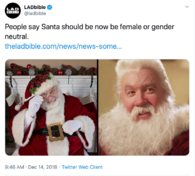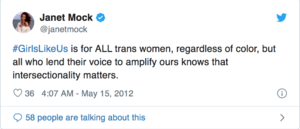Digital feminism
What is Digital Feminism?
Digital feminism can be defined as activism or engagement with feminism and feminist ideologies on the internet. In other words, digital feminism is feminism that takes place in the online realm. [1] Digital feminism is new to the 21st century and gained popularity with the introduction as well as heavy usage of the internet. In fact, most feminist scholars would agree that digital feminism has been the most importance advance in feminism in 50 years. [1]
Online feminism exists as a space in which people from across the world can easily share their ideologies as well as bring light to new feminist issues at a quick pace. Along with being a place in which ideas can be shared at a fast pace, this digital world also allows a space in which people can find solidarity, support and advice by simply browsing a hashtag such as #MeToo. [2] Evidently, while there are some drawbacks to digital feminism, it is ultimately an effective tool in the widespread sharing of feminist activism.
Contributions of Digital Feminism

An important contribution of digital feminism is the production of hashtag activism. Hashtag activism takes place when a social issue is shared and interacted with on social media. Thousands of people use the same hashtag, which then allows others to easily interact with the social issue or movement simply by searching up the hashtag. A phenomenal example of digital feminism, and more specifically hashtag activism can be noted through the hashtag #BringBackOurGirls. This hashtag was created in response to the kidnapping of girls in Nigeria. Since creation, the hashtag created cyber communities which helped bridge the online and offline world. Through this, real feminist movements were created. Within days, other media sources such as global news outlets started to cover this story, and it continued to gain traction. In 2014, the hashtag #BringBackOurGirls was used over four million times. [3] As Okello Kelo Sam, the founder of Hope North, a secondary school for victims of the civil war in Uganda explains, “Social media won’t return our girls, but the world’s attention can help.” Through this quote, the purpose of digital feminism is showcased. Digital feminism is not always capable to solve an issue, but it is plays a significant role in gaining traction and spreading awareness: both of which does eventually cause social change. It is clear that this category of feminism strengthens and broadens the reach of varying women’s movements as it is an easy and effective way to spread awareness. [4]
#MeToo Movement

The #MeToo movement is another hashtag created and shared by digital feminists as a way to bring awareness about sexual harassment and sexual assault women face in the work place. This hashtag is a great source to analyse the communities created through digital feminism. Since creation, people from around the world have been able to safely share their stories on twitter with the use of this hashtag. The #MeToo movement has provided a space in which people can find solidarity and build communities in times of hardship. [2] Digital feminism is also an important tool for empowerment. This is seen through this hashtag as women are able to speak up against sexual violence while receiving support from others around the world who may have faced the same experiences. Furthermore, people are able to find resources, advice and support through the content shared within this hashtag. The speed at which messages can be transmitted enhances the potential for social change as a wide audience can be reached in a matter of seconds. [5] As hashtag feminism is one of the most popular forms of feminist activism, it is evident that this category of feminism creates real change. [2]
Limitations of Digital Feminism
Spread of Misinformation

While digital feminism has proven to be a powerful addition to the feminist movement, is not perfect. There are some downsides to digital feminism, one of which is the fact that misinformation can be easily spread and reproduced within a matter of seconds. [1] With this new found online world, anybody can post anything with little to repercussions, this often can entice people to spread misinformation which then continues to be spread as it gains traction. Luckily, people active on social media platforms are often quick to shut down these ideas; however, they sometimes still slip through the cracks, devaluing the true ideologies of feminism. An example of this can be found in tweets allegedly sharing the fact that Feminists want a gender neutral Santa Claus, when in fact many feminists reject this idea. [6] Often, people interact with these tweets using them as leverage to explain why feminism is not necessary in the 21st century.
Inclusivity
Digital feminism is also not all inclusive. While partaking in digital feminism, it is essential to remember and include the people who are not able to be online due to social, political and economic reasons. Digital feminism is most powerful when there is solid connection between the offline and online world, and people of both worlds are working together in solidarity. [2]
Labour Intensive Work
Engaging in digital feminism is often labor intensive work, especially in regards to emotional labor. [7] Because of social media, people are able to engage with your tweets and ideas at any time, and can comment on them within a matter of seconds. Often, online activists are expected to reply to trolls, and other people disagreeing with their ideologies. If not replied to, people often take this as a victory and use it as leverage to prove their own ideas are correct. The labor that small grassroots activists engage with are often not compensated for as they are simply just expected to put in time to reply and engage with the various hashtags and blogs. [7] In regards to digital feminism, it is important to remain mindful of the emotional labour faced by activists who choose to be active on social media.
Online Trolls
With the anonymity that accompanies social media, there are often many bullies and trolls who try to tear down these online feminists. Their critiques often do not even engage with the material shared by these online activists, but instead aim to personally attack these feminists. [8] Luckily, social media platforms have implemented tools in order to block, mute, or hide certain people as well as certain words or phrases. For example, on Twitter, users are able to mute words, phrases or people in a way that they do not ever come across these on their own social media. [9] Even more importantly, people who may find certain hashtags triggering, such as hashtags speaking against sexual violence, are able to quickly and effectively remove these from their social media feeds forever. [9] It is clear that as digital feminism continues to grow, social media platforms are also evolving in order to protect their users.
Despite these minor limitations, the digital space for feminist movements continues to grow into one that is all encompassing. As new challenges arise, social media platforms as well as activists continue to adapt in order to better digital activism.
Popular Digital Feminist Movements

Created by activist Tarana Burker, this hashtag was used to demonstrate the large scale at which sexual assault was happening in the workplace. Since creation, many women are sharing how they overcame sexual violence as well as what to do if you are experiencing sexual harassment or violence. As of November 2019, this hashtag has been used over 19 million times on the social media platform Twitter, and has influenced many social justice rallies around the world. [10]
This hashtag was created by Beverly Gooden in 2014. Since creation, this hashtag has been used 3 million times, primarily composed of tweets sharing the complications of domestic abuse against women and the difficulties of addressing domestic violence. It aims to end the stigmatization domestic abuse survivors endure. [11]

This hashtag was first used in 2014 and has since been used over 200,000 times on twitter. This hashtag stemmed from the struggles racialized women faced when receiving backhanded compliments such as “you’re pretty for a dark girl." [12] It aims to draw attention to racial discrimination women of colour encounter on a daily basis.

This hashtag was created by Janet Mock, a well-known writer, who created the hashtag in order to bring attention to the discrimination Trans women, especially Trans women of colour deal with daily. This hashtag has gained popularity in the social media platform Instagram, with over 800,000 posts containing the hashtag. [13]
This hashtag gained popularity with the story of Sandra Bland, a 28-year-old American women who passed away after a traffic stop encounter with the police. [14] This hashtag has called out the systematic racism that still exists in institutions of power such as the police force. This hashtag has been used over 3 million times, and proves that the voices of marginalized people of colour will not go unheard. [15]
Digital Feminism as a Tool for Change
To conclude, Digital feminism is important as it is an effective tool for creating social movements as well as social change. Furthermore, it creates a space in which women are able to share their ideas and stories without being silenced by others. However, it is important that through the work of digital feminism, people who are not connected to the online world due to political, social or financial reasons are not being forgotten.[16] Moreover, digital feminism is most effective when it encompasses an intersectional approach, recognising all the complexity of social problems rooted in racism, classism, homophobia, transphobia, sexuality, ableism, and more. [5] In addition, the knowledge production that follows digital feminist work is an astonishing, as the ideas and knowledge of thousands of people can be shared with a simple click of a button. While digital feminism is a fairly new addition to feminist work, it is clear that its contributions to feminist work has been great.
References
- ↑ 1.0 1.1 1.2 Daniels, Jessie (2016). "The Trouble with White Feminism: Whiteness, Digital Feminism, and the Intersectional Internet". Gender and Women's Studies: Critical Terrain. 2: 404–413 – via City University Of New York.
- ↑ 2.0 2.1 2.2 2.3 Mendes, Kaitylnn; Ringrose, Jessica (2018). "#MeToo and the promise and pitfalls of challenging rape culture through digital feminist activism". European Journal of Women's Studies. 25(2): 236–246. doi:10.1177/1350506818765318 – via Sage.
- ↑ "#BBCtrending: Five facts about #BringBackOurGirls". BBC News. May 2014.
- ↑ Olson, Candi (March 2016). "#BringBackOurGirls: digital communities supporting real-world change and influencing mainstream media agendas". Feminist Media Studies. 16: 772–787 – via Taylor and Francis Online.
- ↑ 5.0 5.1 Noble, S., & Tynes, B. M. (Eds.). (2016). The Intersectional Internet. Bern, Switzerland: Peter Lang US. Retrieved Nov 28, 2019, from https://www.peterlang.com/view/title/22893
- ↑ Earp, Joseph (December 2018). "'People Want Santa To Be Gender Neutral is a Fake Story". Junkee.
- ↑ 7.0 7.1 Delia Dumitrica & Mylynn Felt (2019) Mediated grassroots collective action: negotiating barriers of digital activism, Information, Communication & Society, DOI: 10.1080/1369118X.2019.1618891
- ↑ Jackson, S. (2018). Young feminists, feminism and digital media. Feminism & Psychology, 28(1), 32–49. https://doi.org/10.1177/0959353517716952
- ↑ 9.0 9.1 "About online abuse". Twitter. November 2019.
- ↑ Brown, Dalvin (October 2018). "19 million tweets later: A look at #MeToo a year after the hashtag went viral". USA Today.
- ↑ "EVERY FEMINIST HASHTAG YOU NEED TO KNOW, FROM #METOO TO #TIMESUP". Your Dream Blog. February 2018.
- ↑ Wren, Penny (May 2016). "The Hashtag that Celebrates Beautiful Black Women". Oprah.
- ↑ Mock, Janet (May 2012). "My Journey (So Far) with #GirlsLikeUs: Hoping for Sisterhood, Solidarity & Empowerment". Janet Mock.
- ↑ "Say Her Name". AAPF.
- ↑ Khaleeli, Homa (May 2016). "#SayHerName: why Kimberlé Crenshaw is fighting for forgotten women". The Guardian.
- ↑ Clark, C. (2015). #TrendingFeminism: The impact of digital feminist activism (Order No. 1589542). Available from ProQuest Dissertations & Theses Global. (1691802140). Retrieved from http://ezproxy.library.ubc.ca/login?url=https://search.proquest.com/docview/1691802140?accountid=14656